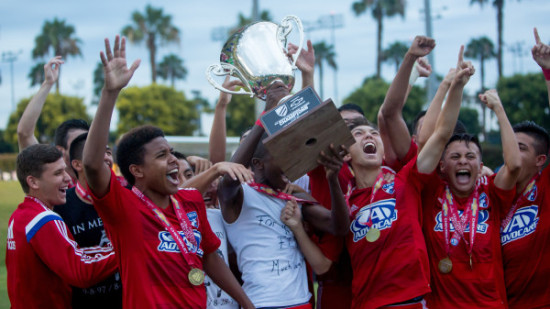Dure: U.S. Soccer’s birth-year plan is shortsighted, helping coaches, not kids
 The U.S. Soccer Federation’s intervention in the messy world of youth soccer is surely overdue. We have a miasma of ego-driven and money-driven decisions that leave a bunch of confused parents shuttling their overburdened kids through long-distance road trips with dubiously qualified coaching gurus. Someone needs to step in and lend some clarity to the situation.
The U.S. Soccer Federation’s intervention in the messy world of youth soccer is surely overdue. We have a miasma of ego-driven and money-driven decisions that leave a bunch of confused parents shuttling their overburdened kids through long-distance road trips with dubiously qualified coaching gurus. Someone needs to step in and lend some clarity to the situation.
The decision to rearrange age groups, though, was neither the most important issue to address nor an elegant solution to a minor problem.
From the viewpoints of Tab Ramos and other U.S. staffers, aligning age groups by birth years must seem sensible. They’re taking kids into international competitions in which age groups are long-established. USSF coaches have to sort through player pools full of kids who play under age groups more closely aligned to the school year. With every player, they must ask whether Player X is really eligible to play U-17.
+ QUIZ: Do you agree with U.S. Soccer’s new youth mandates?
The problem with instituting birth-year age groups all the way through youth soccer, though, is that 99.99 percent of kids who play youth soccer aren’t going into such serious competition. And it’s high time the needs of the “elite” stopped trampling the needs of the recreational player, especially when it’s so easy to address everyone’s needs.
For the U-6s through U-12s I’ve coached, the current system works quite well. The cutoff is August 1, two months ahead of our local schools’ cutoff date. Most kids play with their classmates, easing the transitions into school and soccer and making things … apologies if this is a dirty word to some people … fun.
If your kid is born in August or September, you have a choice. You can play “up” with the kid’s grade level so he or she is with his classmates. Or if your child isn’t physically ready to play in that age group, he or she can be grouped by age instead.
 So not only does the current system allow most kids to play with their peers, it gives parents a tool to combat one of the pernicious problems of youth soccer: the “relative age effect.”
So not only does the current system allow most kids to play with their peers, it gives parents a tool to combat one of the pernicious problems of youth soccer: the “relative age effect.”
With a hard-and-fast cutoff, you’re likely to see the kids born in the first two months of an age-group year excel (January and February, if you’re going by birth year) while the kids in the bottom two months (November and December) struggle. Having a loose cutoff, with August and September kids free to go either direction, parents (with coaches’ input if desired) can drop their kids with late birthdays to the next year. No harm.
And here’s the kicker: There’s no reason USSF can’t keep such a system in place while still simplifying things for Ramos and company.
When youth soccer kids get older, they’re often grouped into age groups of two years, anyway. The Development Academy’s age groups are U-14, U-16 and U-18.
So when kids hit those years, then you can start with the Jan. 1 cutoff.
+READ: SoccerWire Q&A: Kevin Payne on US Club Soccer’s new “Players First” program
Here’s how it could work for this year:
U6: August 1, 2009
U7: August 1, 2008
…
U12: August 1, 2003
U13: August 1, 2002
U14: Jan. 1, 2001
U16: Jan. 1, 1999
(U17 cutoff for 2015 World Cup is Jan. 1, 1998)
U18: Jan. 1, 1997
And so on.

The reality is that national team and Development Academy staffs looking for U-14s are going to be sorting through a lot of different rosters, anyway. A good U-12 will be playing up at the club level. So the shifting cutoff date from U-13 to U-14 shouldn’t upset any of those coaches.
(And if you look at the U.S. U-17 men’s national team player pool, you wonder if they’re looking at anyone born after April, anyway. See “relative age effect” above.)
So you can meet the needs of your elite-level coaches and the rec-level parents at the same time.
That should be a template for how youth soccer is organized in general. If U.S. Soccer is going to take a long-overdue lead role in that organization, why not set the tone right away?
Beau Dure’s new book, Single-Digit Soccer: Keeping Sanity in the Earliest Ages of the Beautiful Game, is now available for pre-order in electronic form at Amazon, Barnes and Noble, and other online booksellers. The paperback edition will be available in September.
SOCCERWIRE MARKETPLACE
- Wanted Licensed Youth Soccer Coach
- Join Official Elite Summer Soccer Camps with Europe’s Top Pro Clubs!
- The St. James FC Travel Staff Coach - North (Loudoun) & South (Fairfax)
- The St. James FC Girls Academy (GA) Head Coach - 2 teams
- The St James FC Boys Travel Tryouts
- OFFICIAL BAYERN MUNICH SUMMER CAMPS U.S.
- JOIN THE ALLIANCE!
- OFFICIAL FC BARCELONA CAMPS U.S.
- The Cup San Diego - Hosted by Legends FC
- Players Wanted - Undergraduate or Post-graduate











